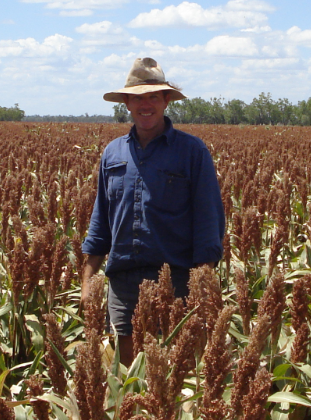Managing subsoil nutrition – grower experience, Lee Jones (Central Queensland Grower Solutions)
Author: Compiled by Hayley Eames (DAF Qld) | Date: 05 Dec 2018
Take home message
My advice would be to just give it a go.
If you suspect that you might have a problem, I would recommend getting some detailed soil tests done at depth and then put down some strip trials with your own planter.
Get a couple of one tonne bags, mark out and then monitor your strips - this will soon give you an indication as to whether you are likely to get a response.
Grower
Lee Jones, Rolleston, Qld.
 Figure 1. Lee Jones
Figure 1. Lee Jones
Farming Area
3500 hectares
What did your previous fertiliser program involve?
60-80kg/ha urea applied pre-plant
What was the driver for undertaking a subsoil nutrition program?
Soil tests showed that phosphorus levels were very low in both the topsoil and subsoil layers with Colwell P values of 3 mg/kg and 1 mg/kg respectively.
How did you go about implementing your subsoil nutrition program?
- Depth: 20cm
- Row Spacing: 40cm
Rates
A strip trial was conducted with three different treatments:
- Control = no fertiliser applied, planter pulled through strip at same depth as deep applied treatments
- 120kg/ha MAP + 60kg/ha Urea ($119/ha)
- 240kg/ha MAP + 120kg/ha Urea ($238/ha)
Equipment
We used a 15 metre Gyral Sure Strike Tyne Planter. No major modifications were required; however, we did raise the coulter and press wheel heights and increased the down pressure on each unit to help keep the planter at depth.
Horsepower wasn’t a problem as we used a John Deere 8360 tractor (360hp capacity). However, we did have to reduce travel speed down to 7km/hr. Fuel use was around 55L/ha compared to 35L/ha under standard operations.
 Figure 2. Gyral Sure Strike planter
Figure 2. Gyral Sure Strike planter
What results have you observed?
Table 1. Yield results from the 2017 wheat crop comparing nil treatment and deep applied fertiliser
Wheat 2017 | |||
|---|---|---|---|
| Nil | 180kg/ha (120kg/ha MAP + 60kg/ha Urea) | 360kg/ha(240kg/ha MAP + 120kg/ha Urea) |
Yield (t/ha) | 1.8 | 2.1 | 2.2 |
Yield increase | +21% | +29% | |
Payback period?
We estimate that we have already recouped 2/3 of the application cost back in our first wheat crop and anticipate a stronger response in the following legume crop. We expect the payback period to be close to 2 years.
Were there any challenges associated with implementing a subsoil fertiliser program?
Getting the timing of application right in order to minimise soil disturbance is critical. When we applied in February 2017 the soil was still quite moist and as such we were continually bringing up large clods of soil, which can present problems when it comes time to plant.
Where to next?
Our plan for the next 3-5 years is to continue to monitor the current site for protein and yield as well as undertake regular soil testing. This should give us a better understanding of what the site can produce overtime as well as the potential longevity of response.
What advice would you have for other growers looking at implementing a subsoil fertiliser program?
My advice would be to just give it a go. If you suspect that you might have a problem, I would recommend getting some detailed soil tests done at depth and then put down some strip trials with your own planter. Get a couple of one tonne bags, mark out and then monitor your strips - this will soon give you an indication as to whether you are likely to get a response.
Contact details
Hayley Eames
DAF Qld, Biloela
Ph: 07 4808 6815
Mb: 0459 813 389
Email: hayley.eames@daf.qld.gov.au
Lee Jones
Mb: 0429 864 594
Email: lajmjones@gmail.com
GRDC code: DAQ00205
GRDC Project Code: DAQ00205,
Was this page helpful?
YOUR FEEDBACK
